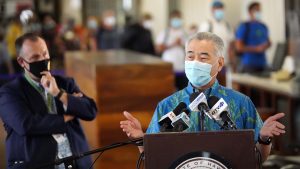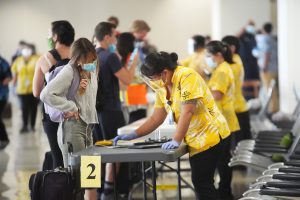A critical time for jobs, health and Hawai’i’s economy
Posted on Oct 28, 2020 in Capitol Connection, FeaturedGovernor Ige called the Oct. 15 trans-Pacific pre-travel testing launch “our single biggest effort since the pandemic began to revive our economy.” With Hawai‘i’s future at stake, federal, state and county governments worked with the airlines, hospitality and business communities to create a multi-layered system of protection. Balancing public health and economic survival depends on everyone staying vigilant and following safety measures. That we’ve come this far is a tribute to all of us doing our part because we love Hawai‘i. That’s something to be grateful for as we head into the holidays.
Q. How is the pre-travel testing program working so far?
A. The response has really exceeded our expectations. We had more than 10,000 incoming passengers on the first day, and an estimated 80 to 85 percent of them had completed a pre-test so they could avoid the14-day quarantine. Passenger counts are now leveling off. Those who had a pre-test done with one of our trusted travel partners and uploaded the results to our Safe Travels site made it through the process pretty quickly. We’re working through other issues for those who need to quarantine until their results come in. With the Safe Travels form, we have a record of everyone coming into the state and their contact information so we can verify they’re abiding by the quarantine.
Q. What is the latest on inter-county travel and what are the differences?
A. Inter-county travelers to Kaua‘i, Maui and Hawai‘i counties can bypass the 14-day quarantine if they take a NAAT test from one of several trusted testing partners no earlier than 72 hours prior to departure and receive a negative result. Those traveling to Hawai‘i County can instead choose to get a post-arrival test from a trusted partner but would have to remain in quarantine until the negative test is reported and verified. Travelers must register and upload their results to their Safe Travels Hawai‘i account and have their test result with them when they arrive. No test and no quarantine are required for in-state travel to O‘ahu.
Q. What gives you confidence that we can handle the influx of travelers while still keeping our case numbers low?
A. We have a strong, multi-layered system to protect the health of our community. That includes having the pre-test for incoming travelers, along with thermal screening at the airports and follow-up testing where possible. We’ve also asked the airlines, hotels and attractions to be our public health partners in reminding visitors about masks and other safety precautions. We still have state and county quarantine enforcement on the job and increased testing, tracing and isolation capacity to combat community spread. It’s all about managing risk to keep our community safe while reviving our economy and continuing to wear a mask, wash our hands and watch our distance.
Q. What update can you provide on the state’s budget deficit and cost-cutting measures?
A. Even with a gradual recovery in tourism, our budget situation is still very bad. Right now we’re projecting an annual deficit of between $1.3 and $1.5 billion every year. Clearly, that’s not sustainable. Furloughs and layoffs are the last resort, but most of our costs are in personnel, so even with other budget cuts we’re still going to have to reduce the size of state government. Every month that we delay is costing us $30 to $40 million. We anticipate having significant budget challenges for the next four years, so we’ll have to come to an agreement with the unions soon. We’re negotiating with collective bargaining representatives to see how we can move forward and right-size state government.

